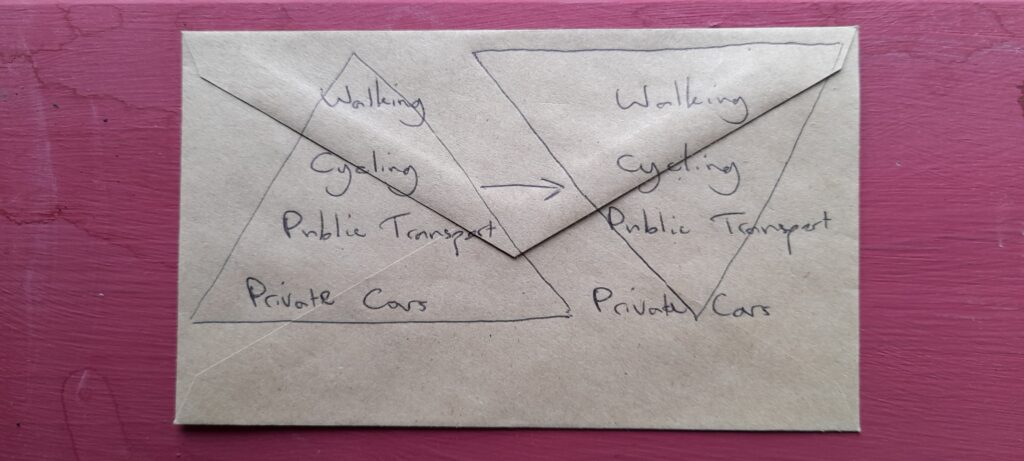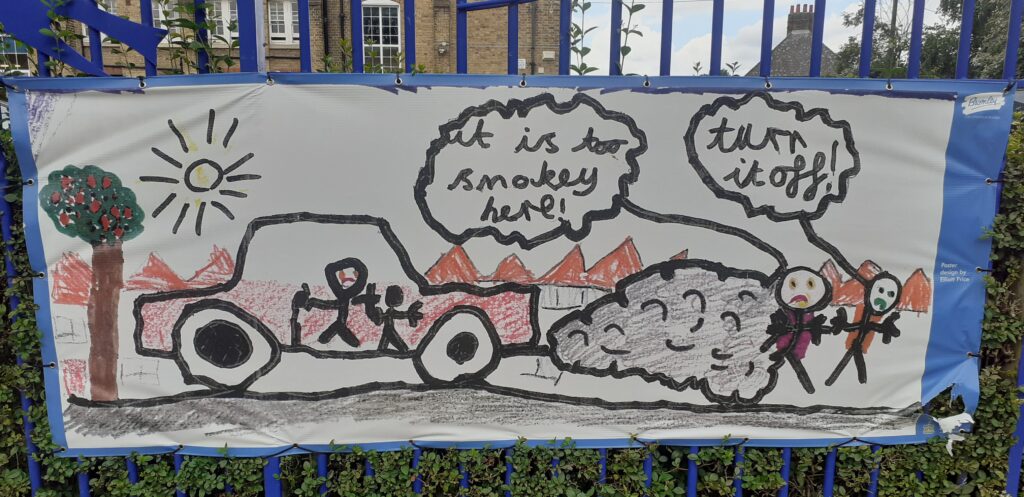Bromley Council is currently consulting on a scheme to improve pedestrian safety and the reliability and punctuality of bus services on Anerley Hill/Anerley Road, between Crystal Palace Parade and Seymour Villas.
Continue reading “Public consultation: Anerley Hill/Anerley Road proposed bus priority and pedestrian safety improvements”New Beckenham Station underpass – concerns over new barriers
In November 2023 Bromley Council installed new barriers at the underpass next to New Beckenham Station, pictured below.

Shortly after these were installed, we contacted ward councillors and council officials to raise concerns about the design of these barriers. Specifically the gap of ~1.15m between each barrier creates a very tight path for anyone travelling on a mobility scooter or wheelchair, using a cargo bike or handcycle (when dismounted), or with a double buggy.
As far as we know, council officials are considering whether the barriers could be adjusted to improve accessibility. We will continue to pursue this issue as the underpass is a key link for walking, cycling and wheeling around Beckenham, and maintaining access for users is essential. Please contact us at bromleygroup@livingstreets.org.uk if you would like to get involved, or have concerns you would like to raise.
Bromley Local Plan: what is a Local Plan, and how can I respond to the Issues and Options consultation?
Concerned about new developments expanding into Green Belt areas in Bromley? Would you like public spaces and streets that are safer for walking and cycling? Or maybe you are worried about whether we are doing enough about air pollution or responding to the climate crisis? Have your say by responding to Bromley Council’s consultation on the borough’s Local Plan.
Continue reading “Bromley Local Plan: what is a Local Plan, and how can I respond to the Issues and Options consultation?”16 Bromley schools are doing the Sustrans Big Walk and Wheel 2023! Is yours?
Do you have one or more children at school? If the answer is yes, ask your child/ren’s teachers to register their school now for Sustrans Big Walk and Wheel, the UK’s biggest inter-school walking, wheeling, scooting and cycling to school competition.
Continue reading “16 Bromley schools are doing the Sustrans Big Walk and Wheel 2023! Is yours?”15-Minute Cities Webinar – Recap
In case you missed last night’s webinar on 15-Minute Cities, this blog post summarises the presentations by Alice Roberts from CPRE London and Jeremy Leach from London Living Streets.
Continue reading “15-Minute Cities Webinar – Recap”Bromley Living Streets Webinar – Introducing ’15 Minute Cities’

Bromley Living Streets is delighted to announce a webinar introducing the concept of “15 Minute Cities” as a valuable tool for thinking through the future of town centres/high streets in London Borough of Bromley.
Continue reading “Bromley Living Streets Webinar – Introducing ’15 Minute Cities’”15-Minute Intro to 15-Minute Cities

New Year, New Environment Committee Meeting!
Happy New Year! Can you spare 5 minutes today to send a question to Bromley Council Environment Committee? There’s no time to lose: questions need to be submitted by 5pm on 5 January to be accepted for the committee meeting on 19 January – full details of how to submit questions can be found here, and information about the meeting can be found here.
Bromley Council’s Environment and Community Services PDS Committee examines executive decisions and reviews policy on transport (highways development, traffic, road safety and parking), street services, waste and recycling and parks and open spaces. We in Bromley Living Streets think that asking questions to the Environment Committee is a very valuable way to let the Council know what matters to local people – particularly important to do now, given that local elections are taking place on 5 May 2022. Environment Committee meetings are the place where Bromley Council’s projects and policies are scrutinised, and members of the public raising issues in this forum is an important part of local democracy and a key way of encouraging local councillors to take action.
So what should you ask questions about? That’s up to you, but we have some ideas you might want to consider. Below we present some ideas for questions relating to active travel and safe streets across the borough, including pedestrian crossings, air pollution, school streets, speed limits, Killed or Seriously Injured (KSI) statistics and COP26. We also encourage you to look at the Council’s Environment Matters newsletter (available here) and take this opportunity to ask the Council for clarification or evidence on the topics and claims contained in the newsletter.
Feel free to Blind Carbon Copy (BCC) us into your email when you submit your questions, or forward your submitted questions to us after sending them to committee.services@bromley.gov.uk, so that we are aware of the issues that have been raised.
Potential topics and questions:
Pedestrian crossings
- Bromley’s Air Quality Action Plan was approved at the November 2021 Environment Committee meeting. On the final page of Appendix A, under “Reducing emissions from transport”, it is stated that a target for the number of new pedestrian crossings will be established – when, and based on what evidence?
Air pollution
- Bromley’s Air Quality Action Plan (approved in November 2021) claims no schools in Bromley are exposed to NO2 concentrations that exceed annual limits (page 8). Maps available on the London Air website suggest otherwise. Please set out all the evidence, with references where appropriate, upon which this claim is made.
School Streets
- In July 2021, 500+ School Streets were in place across London. Bromley Council’s website states the borough has 4, but it’s now 3. Given demand from Bromley parents, and evidence of health benefits, road danger reduction, and improved independent mobility for children, will the Council commit to more trials now?
- What would be the cost of one ANPR vehicle to provide enforcement of Bromley School Streets, for one hour at start and finish of the school day for the entire Spring term, and could this cost be covered by the money Bromley Council received from TfL to provide School Streets?
- The Portfolio Holder has previously stated the three schools on Hawksbrook Lane “were very keen” to have a School Street, but this has not been installed due to “the potential number of vehicle movements which still could occur”. Please provide the evidence base that informed this decision.
Speed limits
- In response to previous questions, the Portfolio Holder stated the borough’s experience is that drivers who ignore 30mph limits ignore lower speed limits, and drivers are much more likely to change behaviour where reduced speeds are advised near a clear hazard or justification. Please provide evidence to support this.
- In a Council meeting on 6 December 2021, Councillor Tickner described 20mph speed limits as “socialist”. Does the Portfolio Holder agree with this characterisation?
Net carbon zero target
- The ‘COP26 Special Edition’ of Environment Matters states that “Bromley has always been London’s greenest borough and we have one of the most ambitious net carbon zero targets in the Capital.” Please set out all the evidence, with references where appropriate, upon which this claim is made.
Killed or Seriously Injured (KSI) statistics
- The latest edition of Environment Matters states the 28% reduction in Killed or Seriously Injured (KSI) casualties in 2020 is “perhaps partly explained” by “lockdown”. Would the Portfolio Holder agree that it is very likely that the 19% reduction in vehicle miles travelled in the borough is a factor? (19% figure calculated using DfT statistics from 2019 and 2020, available here)
Please do get in touch with any questions, suggestions, feedback, or if you’d like us to put you in touch with other Bromley Living Streets members living in your neighbourhood.
Best wishes for the New Year from Bromley Living Streets

Disappearing planters! Three reasons this is bad news for the High Street and bad news for residents
Bromley Council has removed planters enabling social distancing on Beckenham High Street and near Bromley South, reinstating a small number of parking spaces. Please write to your elected representatives today to let them know why this is a bad idea, and submit questions to the Portfolio Holder at the next Environment committee meeting (info on how to do this can be found here). The website WriteToThem will give you contact details for your MP, Councillors, and GLA representatives.
Continue reading “Disappearing planters! Three reasons this is bad news for the High Street and bad news for residents”School’s out

As summer term 2021 draws to an end, we at Bromley Living Streets have been reflecting on the last school year. What improvements have we seen in Bromley since September that are enabling children to safely actively travel to school and where is there need for so much more to be done?
Continue reading “School’s out”